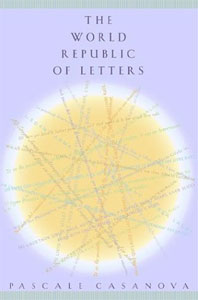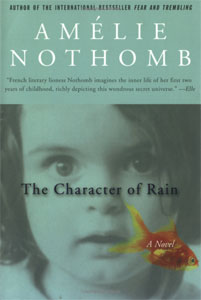I went to Paris last weekend. I have a friend there with an apartment, flights are cheap in the off season, and I’ve never been there before. As might have been expected, I learned absolutely nothing about France. But I did come away with a lot of food for thought about America – specifically, how books work in the United States. Says Gilles Deleuze: “travel does not connect places, but affirms only their difference.” He’s right: sometimes you needs to get away from a place to think about it.
Three observations, then, on how books work in the United States w/r/t my French observations. This post is perhaps less liberal in its interpretation of books than we usually are around here: bear with me for a bit, there’s still plenty of rampant generalizing.
* * * * *
Wandering around the Sorbonne, my friend & I came upon the Librerie Philosophique J. Vrin and went in. It’s a good-sized bookshop that’s devoted entirely to used and new philosophy books, mostly in French, although the neatly categorized shelves are noticeably peppered with other languages. On the Saturday evening I was there, it was full of browsing customers: it’s obviously a working bookstore. We don’t have philosophy book stores in the U.S. One finds, of course, no end of religious bookstores, but unless I’m tremendously mistaken, there’s none dedicated solely to philosophy. (And as far as I know, there’s only one poetry bookstore remaining in the U.S.)
It’s a(n admittedly minor) shock to find oneself in a philosophy bookstore. But a deeper question tugs at me: why aren’t there philosophy book stores in the United States? I’m certainly not qualified to judge what the existence of J. Vrin says about France, but its lack of an analogue in the U.S. clearly says something (besides the obvious “the market won’t support it”). Are we not thinking about big ideas and shipping them about in books? Are the only people who need to read Plato our neocon overlords? Why don’t we need books like these?
* * * * *
Another thing you notice at J. Vrin, as well as elsewhere in Paris: how monotone the books are. It’s not quite a color-coordinated bookstore but it’s close: just about every spine is white, a smaller number being yellow, a smattering of other colors. If you pull a book out, the cover designs are mostly in a classic French style: lots of space, Didot type, some discreet flourishes. These two are typical:


I’m not tremendously interested in French book style of itself, though: I’m more interested in what this minimalist tendency reveals about American book design and the ideas behind it. A trio of comparisons: the French on the left of each pair, the American on the right:
The American covers seem more designed – not necessarily better designed, that goes both ways – but they clearly exist as marketing. The French book covers aren’t advertising in the same way that the American book covers are. The implication here seems to be that French books are for reading, rather than for looking at. Nobody’s going to pick up one of those because of the way the cover looks. It’s presumed that the reader is already interested in the content of the book; what’s on the cover won’t change that interest. There’s a lot more variety in the American books: I might be persuaded to pick up the Deleuze book on Proust (where the quotation above came from) because it looks nice, or dissuaded from picking up the Amélie Nothomb book because it looks so horrible & the title was mangled into something out of Crate & Barrel.
 There’s an essay by Jan Tschichold, the doyen of modern book design, advising the reader that the jacket of a hardcover book should be taken off and thrown away as soon as you get the book home. This seems heretical to a book collector (or designer), but I think his point ultimately makes sense: books shouldn’t exist as art objects, they exist to be read. Design should focus attention on, not deflect attention from, the ideas in the book. American book design has drifted away from that precept. (Tschichold, were he still alive, might argue that it’s failed entirely: that essay appears in a book titled The Form of the Book: Essays on the Morality of Good Design which has hardened into an art object: get a used copy for $102.50.)
There’s an essay by Jan Tschichold, the doyen of modern book design, advising the reader that the jacket of a hardcover book should be taken off and thrown away as soon as you get the book home. This seems heretical to a book collector (or designer), but I think his point ultimately makes sense: books shouldn’t exist as art objects, they exist to be read. Design should focus attention on, not deflect attention from, the ideas in the book. American book design has drifted away from that precept. (Tschichold, were he still alive, might argue that it’s failed entirely: that essay appears in a book titled The Form of the Book: Essays on the Morality of Good Design which has hardened into an art object: get a used copy for $102.50.)
Probably I didn’t need to go to France to figure this out: scrutinizing the Spanish and Bangla bookshops and bookcarts in my neighborhood reveals book covers that are closer to French than American design.
* * * * *
Back to advertising: in the windows of wine bars, one sees volumes of Deleuze and Julia Kristeva, not exactly what we usually construe as light café reading. These books are cultural signifiers: presumably the right sort of passersby see them and understand that the winebar is the right sort of place for people like them. Could you do this in the U.S.? You could; by putting Stanley Cavell and Peter Singer in the window, I suspect that you’d attract a lot of confusion and maybe, if you were lucky, some shabby grad students. In Paris: pretty people. (Are they actually interested in Kristeva and Deleuze, or are they just interested in the wine? Again: no idea.)
It’s worth pointing out that Paris didn’t seem technologically reactionary to me: books haven’t succeeded at the expense of newer media. Paris is full of wireless, for example, and URLs are splattered all over advertisements. If anything, books seem to have succeeded with new media: a casual flip through the enormous number of channels on my friend’s television yielded a couple of book review programs. Again: books are part of the cultural discourse there in a way that isn’t the case here.
* * * * *
I haven’t mentioned snobbery yet, though that’s obviously an essential part of this discourse. No one imagines that the majority of the French care that much about Derrida, and it’s clear the French have their own problems which don’t need my interpretations. And more importantly: it would be foolish to jump to the conclusion that America is anti-literary. I’m reminded of the bit in Proust’s Time Regained where the Baron de Charlus, equally drawn to both sides in WWI, declares himself pro-German because he’s surrounded by people parroting pro-French platitudes and he can’t stand them. I won’t deny that there’s a little bit of Charlus in my stance. But I do think that the lens of snobbery can be a useful way to scrutinize how cultural capital works, and this analysis can be broadened to look at the sort of big-picture questions we’re interested in at the Institute. Nor am I the only one who’s noticed this: a better analysis than my own can be found in Pascale Casanova’s The World Republic of Letters (depicted above in both French and American editions), a book from a few years ago:
. . . New York and London cannot be said to have replaced Paris in the structure of literary power: one can only note that, as a result of the generalization of the Anglo-American model and the growing influence of financial considerations, these two capitals tend to acquire more and more power in the literary world. But one must not oversimplify the situation by applying a political analysis that opposes Paris to New York and London, or France to the United States.”
(p. 168.) Casanova’s book is a nice (and readable) study of how literature functions globally as cultural capital; this review by William Deresiewicz in The Nation is a serviceable introduction. It’s a useful text for thinking about how big ideas have historically been “legitimated” (her term) and disseminated. Along the way, she can’t help but make a strong case for Paris being the historic arbiter of much of the world’s taste: Joyce, Faulkner, Borges, Wiesel (a list which could be extended at length) all first came to global prominence through French interest.
Another reminder that things are different in different countries: earlier this week, Pedro Meyer, the Mexican photographer who runs ZoneZero had a long lunch with the Institute, where he reiterated that the way books function in the U.S. is not necessarily the way they function in Latin America, where books are much scarcer and bookshops generally nonexistent. Meyer’s concerns echo those of Nigerian writer Chinua Achebe who blisters at American critics arguing that African novels are universal, only with different names:
“Does it ever occur to these [academics] to try out their game of changing names of characters and places in an American novel, say, a Philip Roth or an Updike, and slotting in African names just to see how it works? But of course it would not occur to them. It would never occur to them to doubt the universality of their own literature. In the nature of things the work of a Western writer is automatically informed by universality. It is only others who must strain to achieve it . . . I should like to see the word ‘universal’ banned altogether from discussions of African literature until such time as people cease to use it as a synonym for the narrow, self-serving parochialism of Europe, until their horizon extends to include all the world.”
(p. 156 in Casanova.) Culture cuts both ways. It’s important to remember that the ways books (and, by extension, their electronic analogues) function in American society isn’t the only way they can or should function. We tend to fall into the assumption that there is no alternative to the way we live. This is myopia, a myopia we need to continually recognize.







Dan,
The difference between French book design, including the dearth of many hardbacke, and American has always interested me, and you’ve hit on what I’ve thought were the clear explanations for this difference. And the side-by-side comparisons were a great idea.
There is at least one other poetry-only bookstore in the Country: The Grolier Poetry Book Shop in Cambridge, Massachusetts. I think all the poetry bookshops in New York City are shut down, but I could be wrong about this.
Geof
“The implication here seems to be that French books are for reading, rather than for looking at. Nobody’s going to pick up one of those because of the way the cover looks.”
It’s a principle of library marketing that book covers do make the difference. Tempting readers with attractive book displays is part of our cunning plan to pimp reading to the masses.
One professor I had lo these many years ago said that the introduction of the Mylar book jacket, which allowed libraries to keep the paper jackets on books, was significant to the evolution of the public library, and was a necessary step on the way to more strategic marketing of library materials.
Interesting–sad, maybe?–that your biblioexplorations didn’t include a library. In this country, you can find philosophy titles at your local library–and if it’s not on the shelf, chances are good they can get it for you quickly from somewhere else. Part of that library “long tail” we’re good at in many parts of the country.
I’d be curious to read about the comparative success of public libraries in France. My jingoistic guess is that the typical public library in the U.S. has circ stats that blow any comparable French library out of the water, but I’m open to actual data, whatever it is.
Fascinating. I had always wondered about that when in France, or even at the Alliance Française: was it a part of a grander system of book design? I wondered. Even American and British Commonwealth covers, too, tend to differ, occasionally on the same lines. The British editions seem to place typography slightly ahead of the American ones, where the graphic speaks most loudly.
Paris!
While its selection was pretty broad, Great Expectations in Evanston, which I stared at from a train platform for 5 years, emphasized its philosophy section. But, sadly, it’s now closed.
Dan,
You seem to be conflating design with marketing, thereby aligning yourself (perhaps unintentionally) with a kind of severity in design that even Tschichold and the moderns would have disavowed. It’s a position that doesn’t leave much room for design that’s in dialogue with the content or otherwise contributes a critical perspective, as most serious contemporary graphic design (both here and abroad) endeavors to do.
Also, the crisis in the American book business has been killing independent booksellers, specialty and otherwise, for some time. Are the French experiencing similar casualties, and if not, why not? I’d be curious to know how the culture of bookbuying is different there. Do they have Barnes & Noble in France? Do French people buy books on Amazon? etc. etc.
Rebecca
This post was a Ringleader’s Selection for the Carnival of the Infosciences #25.
http://tinyurl.com/h2paa
Here in Argentina, which always wanted to be like France, the book covers also are rather plain though that’s beginning to change as more people trained and educated in book/editorial design go to work for the publishing houses. I could go on about graphic design and book publishing but I’m more interested in the remarks about books in Latin America.
Of course, Latin America doesn’t really exist except as a concept among North Americans. In the same way, Argentina isn’t anymore representative of Spanish-speaking countries than Mexico but in Argentina there is the widespread availability of books. In Buenos Aires bookstores are everywhere.
The most startling aspect to books in Argentine society for me is that newspapers often come with books. Last year I acquired a dozen books by Borges with my Wednesday edition of La Nacion. Each book was only $5 pesos (less than $2 US). In the bookstores the same book (different edition but same content) retails for more then $30 pesos.
So, even while there are many bookstores in Buenos Aires, the newspapers are actually one of the largest distributors of books. Furthermore, one of the newspapers also publish a regular series of articles on its front page titled “Interviews with Intellectuals of the World” with people like Tzvetan Todorov. I can’t imagine that on the front page of a US newspaper.
Another interesting comparison to make in how titles of books are translated. Take for example Jose Saramago. He published in his native language an amazing novel called, “An Essay on Blindness” (appropriately named for this post.) In Israel, the title was translated into “On Blindness.” And in the US, the title was shortened to simply “Blindness.” It seems that publishers have an eye towards tailoring not only covers but titles as well to suit the perceived tastes of their markets.
Alas, I was away for the weekend, so comments have piled up. In approximately chronological order, then:
Geof: I knew and loved the Grolier Poetry Book Shop – and once even managed to buy a book there that didn’t make Luisa seem deeply disappointed in my taste – but as far as I know – I believe I last went by about a year ago – it’s no longer open to the public. Maybe it’s now open by appointment? can’t tell from the website.
K. G.: I did in fact go to the very exciting (and monumental) Bibliothè que nationale François-Mitterand and took a great many pictures of the experience but! I can’t find the cord to my camera to get the pictures on to the computer. Possibly there will be a sequel? this post was already jam-packed.
Rebecca: does design really need my help to conflate itself with marketing? Design’s complicity in capitalism is an enormous topic, even if it’s rarely seriously addressed (though see this lovely interview with Judith Williamson in dot dot dot, much extended in the print version). My argument isn’t with serious design: certainly I think the American Proust & Signs cover, foe example, is a beautiful piece of work, even if it doesn’t reflect any more knowledge of the text inside than knowing the madeleines were important to Proust’s book. The problem is with most cover design, which is actively bad. The French covers seem to center tightly around a fixed point, which isn’t bad; American ones are wildly all over the place.
It’s maybe worth quoting Tschichold’s essay (“Jacket and Wrapper”, originally published in 1946) at some length, just because I was quoting him from memory, it’s not readily available, and it has become such a strange text:
(pp. 161-162 in The Form of the Book: Essays on the Morality of Good Design) Tschichold’s argument is dated: he’s clearly talking about hard-cover books (this is from before his spin at Penguin made him synonymous with good paperbacks). A particularly interesting bit: “the visible advertising is annoying”. This still rings true to me: one shouldn’t pay for advertising. Tschichold’s also emphasizing how the jacket functions within capitalism, which generally tends to get lost when these things are discussed even though it is the eight-hundred pound gorilla in the room. Books and their jackets exist within an economic system (this is why I was bringing in Casanova); it seems clear to me that books, like bookshops, function better in some economic systems than other and we shouldn’t blithely assume that design is immune to these forces.
And to reiterate: I don’t know really know anything about the French & books, this is very much amateur observation. I suspect, based on my limited observations, that there’s much more of a book culture in France, but I’m certainly in no position to be making pronouncements about that. Anybody?
Mark: thanks.
Jeff: thanks for weighing in! we don’t hear nearly enough from people outside the U.S. which leads to problematic generalizations.
Ray: my third example is a lovely novel by Amélie Nothomb, the title in French being The Metaphysics of Tubes, the English being The Character of Rain. Presumably the American publisher was afraid of metaphysics.
Couple more thoughts; in the US book publishing and distribution has taken gargantuan proportions with your Barnes and Noble and your Amazon, therefore the small bookshop is disappearing. So here, books are commercial goods, bedizened to compete in a crowded market. On the other hand, printing presses such as Gallimard or Espasa Calpe use a uniform cover design for all their books (Espasa changes colors according to genre) because they have a public. The reader of philosophy usually goes to the bookstore with a particular book, or at least an author, in mind. They don’t need to be enticed to buy; they are hooked already.
Two comments on reading in the Spanish and Portuguese -speaking worlds (therefore we could include Africa here;) books are still precious because your young intellectuals barely have enough for the coffee and cigarettes that accompany long conversations on books, so books are exchanged and passed from hand to hand. And yes, in our big cities there are many bookstores (of course I come from a publishing center, as are Mexico, Argentina, and Spain.) In Colombia, newspapers still publish books in weekly installments, and when a new book by García Márquez comes out, it is sold in newspaper stands and peddled by street vendors as the new, hot thing. And people actually read them.
A last comment on universalism in literature; it is not a matter of changing the names of characters for African or Spanish names. A book is universal when it addresses the big questions of mankind, not the European or American ones but the metaphysical ones, the ones that identify us as human beings. Carlos Fuentes said something interesting about Latin American literature in an interview on NPR: Latin America has found its voice, therefore our writers don’t have to write about Latin America anymore, they can write about whatever they please. It is a matter of voice.
There is certainly a lot of bad book design out there, most of which is motivated by market forces and has no substantial relationship with content. I actually think the Proust cover falls more into this category than what I would refer to as serious design: it’s formally coherent and respectful of the content, but as you observed, doesn’t add anything to the reader’s experience of the text. At best it acts as a loose precis of the book’s content but misses an opportunity to critically engage the reader before they even open the book.
I guess my point is that given IFB’s mission, it seems less interesting to talk about design as a monolithic enterprise than it is to think about the ways different approaches to design can expand the reader’s relationship with the content.